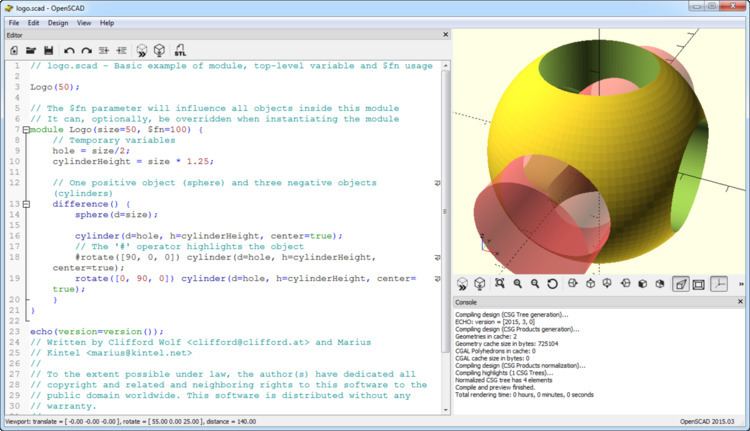Development status Active | ||
 | ||
Developer(s) Marius Kintel, Clifford Wolf Initial release 19 February 2010 (2010-02-19) Stable release 2015.03 / 10 March 2015; 2 years ago (2015-03-10) Preview release 2017.02.08 / 8 February 2017; 43 days ago (2017-02-08) Repository github.com/openscad/openscad/ | ||
OpenSCAD is a free software application for creating solid 3D CAD (computer-aided design) objects. It is a script-only based modeller that uses its own description language; parts can be previewed but cannot be interactively selected or modified by mouse in the 3D view. An OpenSCAD script specifies geometric primitives (such as spheres, boxes, cylinders etc.) and defines how they are modified and combined (for instance by intersection, difference, envelope combination and Minkowski sums) to render a 3D model. As such, the program does constructive solid geometry (CSG). OpenSCAD is available for Windows, Linux and OS X.
Contents
Previewing
For fast previewing of models using z-buffering, OpenSCAD employs OpenCSG and OpenGL.
The 3D model position can be interactively manipulated in the view with a mouse similarly to other 3D modellers. It is also possible to define a default 'camera' position in the script.
Part colors can be defined in the 3D view (including transparency).
Preview is relatively fast and allow interactive modifications while modifying the script.
The model renderer takes into account lighting, but the lighting source is not modifiable.
3D volumes computation
In contrast, CGAL is used for full 3D geometry rendering, which, as with other CSG geometry engines, can sometimes take several minutes or hours to complete.
Use
OpenSCAD allows a designer to create accurate 3D models and parametric designs that can be easily adjusted by changing the parameters.
OpenSCAD documents are human-readable scripts in plain ASCII text.
As such, OpenSCAD is a programmer-oriented solid-modeling tool, and has been recommended as an entry-level CAD tool for designing open-source hardware such as scientific tools for research and education.
It is mostly used to design 3D printed parts which are exported in STL format.
Exportation
Importation
Animation
Animation is possible with a speed of a few images per seconds for simple models. The animation can have effect on any parameter, being it the camera position or the parts dimensions, position, shape or existence. It can be recorded as a set of images usable to build films.
Design
OpenScad is a wrapper to a CSG engine with a GUI interface and integrated editor, developed in C++. As of 2016, it uses the Computational Geometry Algorithms Library (CGAL) as its basic CSG engine.
Its script syntax is based upon functional programming philosophy and does not use real variables.
